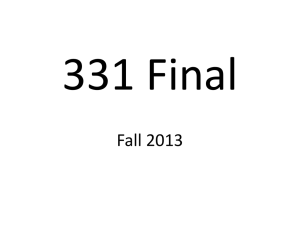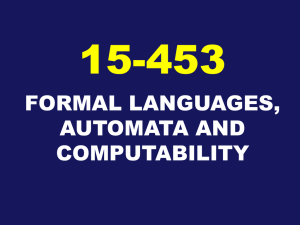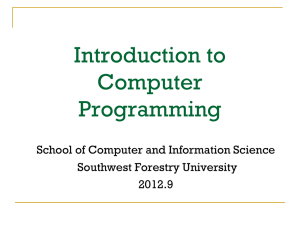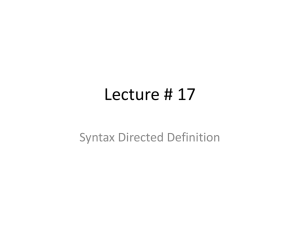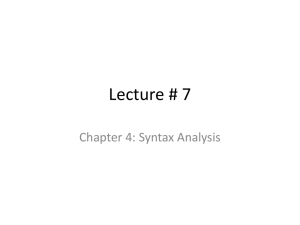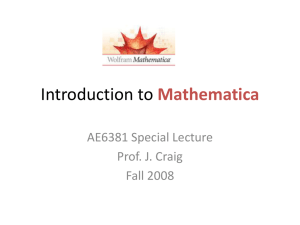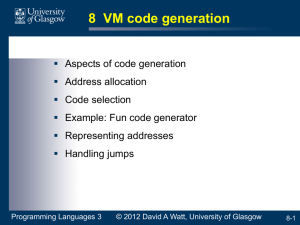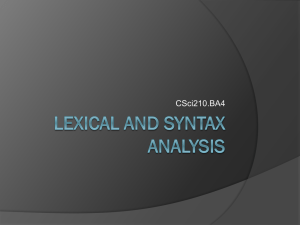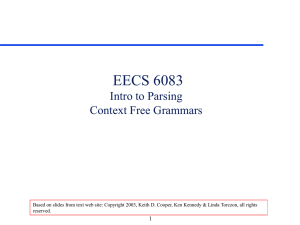Chapter 3
advertisement
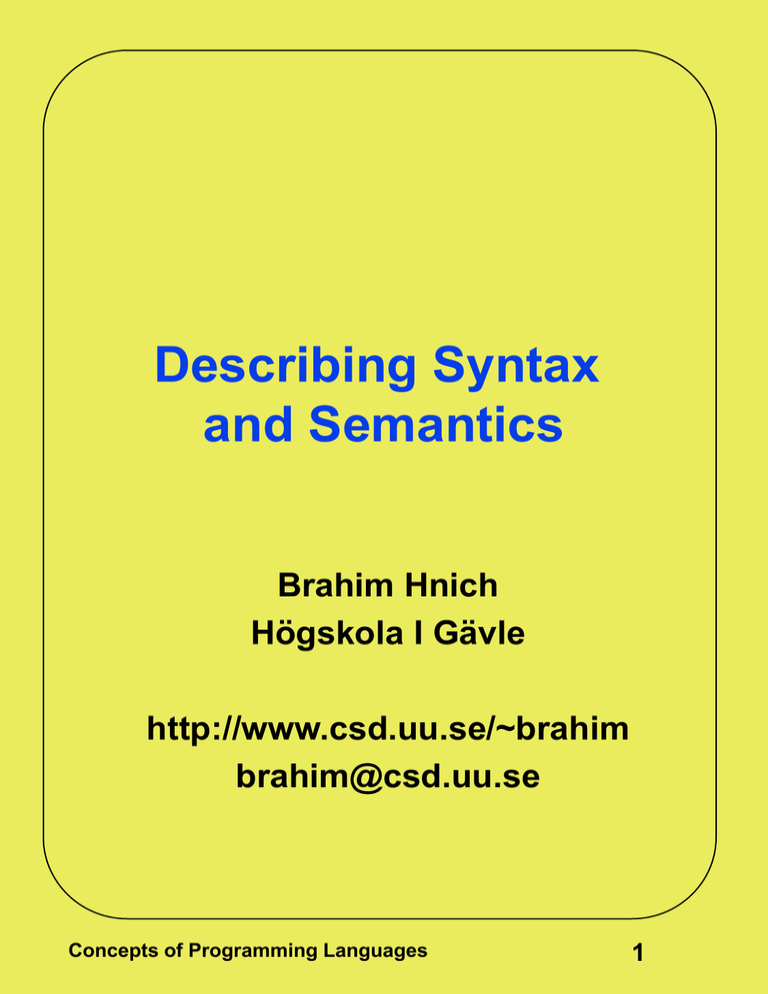
Describing Syntax
and Semantics
Brahim Hnich
Högskola I Gävle
http://www.csd.uu.se/~brahim
brahim@csd.uu.se
Concepts of Programming Languages
1
Overview
• Introduction
• Syntax
– BNF
» Parse Trees
– EBNF
– Recursive descent parsing
• Semantics
– Operational Semantics
– Axiomatic Semantics
– Denotational Semantics
Concepts of Programming Languages
2
Introduction
Syntax - the form or structure of the expressions,
statements, and program units
Semantics - the meaning of the expressions,
statements, and program units
Who must use language definitions?
1. Other language designers
2. Implementors
3. Programmers (the users of the language)
A sentence is a string of characters over some
alphabet
A language is a set of sentences
A lexeme is the lowest level syntactic unit of a
language (e.g., *, sum, begin)
A token is a category of lexemes (e.g., identifier)
Formal approaches to describing
syntax:
1. Recognizers - used in compilers
2. Generators - what we'll study
Concepts of Programming Languages
3
Syntax
Context-Free Grammars
- Developed by Noam Chomsky in the mid-1950s
- Language generators, meant to describe the
syntax of natural languages
- Define a class of languages called context-free
languages
Backus Normal Form (1959)
- Invented by John Backus to describe Algol 58
- BNF is equivalent to context-free grammars
A metalanguage is a language used to describe
another language.
In BNF, abstractions are used to represent classes
of syntactic structures--they act like syntactic
variables (also called nonterminal symbols)
e.g.
<while_stmt> -> while <logic_expr> do <stmt>
This is a rule; it describes the structure of a while
statement
Concepts of Programming Languages
4
Backus-Naur Form (BNF)
A rule has a left-hand side (LHS) and a right-hand
side (RHS), and consists of terminal and
nonterminal symbols
A grammar is a finite nonempty set of rules
An abstraction (or nonterminal symbol) can have
more than one RHS
<stmt> -> <single_stmt>
| begin <stmt_list> end
Syntactic lists are described in BNF using recursion
<ident_list> -> ident
| ident, <ident_list>
A derivation is a repeated application of rules,
starting with the start symbol and ending with a
sentence (all terminal symbols)
Concepts of Programming Languages
5
Backus-Naur Form II
An example grammar:
<program> -> <stmts>
<stmts> -> <stmt> | <stmt> ; <stmts>
<stmt> -> <var> = <expr>
<var> -> a | b | c | d
<expr> -> <term> + <term> | <term> - <term>
<term> -> <var> | const
An example derivation:
<program> => <stmts> => <stmt>
=>
=>
=>
=>
=>
<var> = <expr> => a = <expr>
a = <term> + <term>
a = <var> + <term>
a = b + <term>
a = b + const
Every string of symbols in the derivation is a
sentential form
A sentence is a sentential form that has only
terminal symbols
A leftmost derivation is one in which the leftmost
nonterminal in each sentential form is the one that
is expanded
A derivation may be neither leftmost nor rightmost
Concepts of Programming Languages
6
BNF: Parse Trees
A parse tree is a hierarchical representation of
a derivation
<program>
<stmts>
<stmt>
<var>
a
=
<expr>
<term>
<var>
+
<term>
const
b
A grammar is ambiguous iff it generates a
sentential form that has two or more distinct parse
trees
Concepts of Programming Languages
7
BNF: Parse Trees II
An ambiguous expression grammar:
<expr> -> <expr> <op> <expr>
<op> -> / | -
<expr>
<expr>
|
<expr>
<op> <expr>
<expr> <op>
<expr><op><expr>
const
-
const
const
<expr>
<expr><op><expr>
/
const
const - const / const
If we use the parse tree to indicate precedence
levels of the operators, we cannot have ambiguity
An unambiguous expression grammar:
<expr> -> <expr> - <term> | <term>
<term> -> <term> / const | const
<expr>
<expr>
-
<term>
<term>
<term>
const
const
/
const
!
Concepts of Programming Languages
8
BNF: Parse Trees III
<expr> =>
=>
=>
=>
<expr> - <term> => <term> - <term>
const - <term>
const - <term> / const
const - const / const
Operator associativity can also be indicated by a
grammar
<expr> -> <expr> + <expr>
<expr> -> <expr> + const
|
|
const
const
(ambiguous)
(unambiguous)
<expr>
<expr>
<expr> +
+
const
const
const
Extended BNF (just abbreviations):
1. Optional parts are placed in brackets ([])
<proc_call> -> ident [ ( <expr_list>)]
2. Put alternative parts of RHSs in parentheses and
separate them with vertical bars
<term> -> <term> (+ | -) const
3. Put repetitions (0 or more) in braces ({})
<ident> -> letter {letter | digit}
Concepts of Programming Languages
9
EBNF
Extended BNF (just abbreviations):
1. Optional parts are placed in brackets ([])
<proc_call> -> ident [ ( <expr_list>)]
2. Put alternative parts of RHSs in parentheses and
separate them with vertical bars
<term> -> <term> (+ | -) const
3. Put repetitions (0 or more) in braces ({})
<ident> -> letter {letter | digit}
Concepts of Programming Languages
10
EBNF II
BNF:
<expr> -> <expr> + <term>
| <expr> - <term>
| <term>
<term> -> <term> * <factor>
| <term> / <factor>
| <factor>
EBNF:
<expr> -> <term> {(+ | -) <term>}
<term> -> <factor> {(* | /) <factor>}
Syntax Graphs - put the terminals in circles or
ellipses and put the nonterminals in rectangles;
connect with lines with arrowheads
e.g., Pascal type declarations
type_identifier
(
identifier
)
,
constant
..
Concepts of Programming Languages
constant
11
Recursive Descent
Parsing
- Parsing is the process of tracing or constructing
a parse tree for a given input string
- Parsers usually do not analyze lexemes; that is
done by a lexical analyzer, which is called by the
parser
- A recursive descent parser traces out a parse
tree in top-down order; it is a top-down parser
- Each nonterminal in the grammar has a
subprogram associated with it; the subprogram
parses all sentential forms that the nonterminal
can generate
- The recursive descent parsing subprograms are
built directly from the grammar rules
- Recursive descent parsers, like other top-down
parsers, cannot be built from left-recursive
grammars
Concepts of Programming Languages
12
Recursive Descent
Parsing II
Example: For the grammar:
<term> -> <factor> {(* | /) <factor>}
We could use the following recursive descent
parsing subprogram (this one is written in C)
void term() {
factor(); /* parse the first factor*/
while (next_token == ast_code ||
next_token == slash_code) {
lexical(); /* get next token */
factor(); /* parse the next factor */
}
}
Skip section 3.5 about attribute grammars
Concepts of Programming Languages
13
Dynamic Semantics
- No single widely acceptable notation or formalism
for describing semantics
Operational Semantics
- Describe the meaning of a program by executing
its statements on a machine, either simulated or
actual. The change in the state of the machine
(memory, registers, etc.) defines the meaning of
the statement
Concepts of Programming Languages
14
Dynamic Semantics II
- To use operational semantics for a high-level
language, a virtual machine is needed
- A hardware pure interpreter would be too expensive
- A software pure interpreter also has problems:
1. The detailed characteristics of the particular
computer would make actions difficult to
understand
2. Such a semantic definition would be machinedependent
- A better alternative: A complete computer
simulation
- The process:
1. Build a translator (translates source code to the
machine code of an idealized computer)
2. Build a simulator for the idealized computer
- Evaluation of operational semantics:
- Good if used informally
- Extremely complex if used formally (e.g., VDL)
Concepts of Programming Languages
15
Dynamic Semantics III
Axiomatic Semantics
- Based on formal logic (first order predicate
calculus)
- Original purpose: formal program verification
- Approach: Define axioms or inference rules for
each statement type in the language
(to allow transformations of expressions
to other expressions)
- The expressions are called assertions
- An assertion before a statement (a precondition)
states the relationships and constraints among
variables that are true at that point in execution
- An assertion following a statement is a
postcondition
- A weakest precondition is the least restrictive
precondition that will guarantee the postcondition
- Pre-post form: {P} statement {Q}
- An example: a := b + 1 {a > 1}
One possible precondition: {b > 10}
Weakest precondition:
{b > 0}
Concepts of Programming Languages
16
Dynamic Semantic VI
Program proof process: The postcondition for the
whole program is the desired results. Work back
through the program to the first statement. If the
precondition on the first statement is the same as
the program spec, the program is correct.
- An axiom for assignment statements:
{Qx->E} x := E {Q}
- The Rule of Consequence:
{P} S {Q}, P' => P, Q => Q'
{P'} S {Q'}
- An inference rule for sequences
- For a sequence S1;S2:
{P1} S1 {P2}
{P2} S2 {P3}
the inference rule is:
{P1} S1 {P2}, {P2} S2 {P3}
{P1} S1; S2 {P3}
Concepts of Programming Languages
17
Dynamic Semantics V
- An inference rule for logical pretest loops
For the loop construct:
{P} while B do S end {Q}
the inference rule is:
(I and B) S {I}
{I} while B do S {I and (not B)}
where I is the loop invariant.
Characteristics of the loop invariant
I must meet the following conditions:
1. P => I (the loop invariant must be true initially)
2. {I} B {I} (evaluation of the Boolean must not
change the validity of I)
3. {I and B} S {I} (I is not changed by executing
the body of the loop)
4. (I and (not B)) => Q (if I is true and B is false,
Q is implied)
5. The loop terminates (this can be difficult to
prove)
Concepts of Programming Languages
18
Dynamic Semantics VI
- The loop invariant I is a weakened version of the
loop postcondition, and it is also a precondition.
- I must be weak enough to be satisfied prior to the
beginning of the loop, but when combined with the
loop exit condition, it must be strong enough to
force the truth of the postcondition
- Evaluation of axiomatic semantics:
1. Developing axioms or inference rules for all of
the statements in a language is difficult
2. It is a good tool for correctness proofs, and an
excellent framework for reasoning about
programs, but it is not as useful for language
users and compiler writers
Denotational Semantics
- Based on recursive function theory
- The most abstract semantics description method
- Originally developed by Scott and Strachey (1970)
Concepts of Programming Languages
19
Denotational Semantics
- The process of building a denotational spec for a
language:
1. Define a mathematical object for each language
entity
2. Define a function that maps instances of the
language entities onto instances of the
corresponding mathematical objects
- The meaning of language constructs are defined
by only the values of the program's variables
- The difference between denotational and
operational semantics: In operational semantics,
the state changes are defined by coded
algorithms; in denotational semantics, they are
defined by rigorous mathematical functions
- The state of a program is the values of all its
current variables
s = {<i1, v1>, <i2, v2>, …, <in, vn>}
- Let VARMAP be a function that, when given a
variable name and a state, returns the current
value of the variable
VARMAP(ij, s) = vj
Concepts of Programming Languages
20
Denotational Semantics III
1. Decimal Numbers
<dec_num> 0 | 1 | 2 | 3 | 4 | 5 | 6 | 7 | 8 | 9
| <dec_num> (0 | 1 | 2 | 3 | 4 |
5 | 6 | 7 | 8 | 9)
Mdec('0') = 0, Mdec ('1') = 1, …, Mdec ('9') = 9
Mdec (<dec_num> '0') = 10 * Mdec (<dec_num>)
Mdec (<dec_num> '1’) = 10 * Mdec (<dec_num>) + 1
…
Mdec (<dec_num> '9') = 10 * Mdec (<dec_num>) + 9
Concepts of Programming Languages
21
Denotational Semantics IV
2. Expressions
Me(<expr>, s) =
case <expr> of
<dec_num> => Mdec(<dec_num>, s)
<var> =>
if VARMAP(<var>, s) = undef
then error
else VARMAP(<var>, s)
<binary_expr> =>
if (Me(<binary_expr>.<left_expr>, s) = undef
OR Me(<binary_expr>.<right_expr>, s) =
undef)
then error
else
if (<binary_expr>.<operator> = ë+í then
Me(<binary_expr>.<left_expr>, s) +
Me(<binary_expr>.<right_expr>, s)
else Me(<binary_expr>.<left_expr>, s) *
Me(<binary_expr>.<right_expr>, s)
Concepts of Programming Languages
22
Denotational Semantics IV
3 Assignment Statements
Ma(x := E, s) =
if Me(E, s) = error
then error
else s’ = {<i1’,v1’>,<i2’,v2’>,...,<in’,vn’>},
where for j = 1, 2, ..., n,
vj’ = VARMAP(ij, s) if ij <> x
= Me(E, s) if ij = x
4 Logical Pretest Loops
Ml(while B do L, s) =
if Mb(B, s) = undef
then error
else if Mb(B, s) = false
then s
else if Msl(L, s) = error
then error
else Ml(while B do L, Msl(L, s))
Concepts of Programming Languages
23
Denotational Semantics V
- The meaning of the loop is the value of the
program variables after the statements in the loop
have been executed the prescribed number of
times, assuming there have been no errors
- In essence, the loop has been converted from
iteration to recursion, where the recursive control
is mathematically defined by other recursive state
mapping functions
- Recursion, when compared to iteration, is easier
to describe with mathematical rigor
Evaluation of denotational semantics:
- Can be used to prove the correctness of programs
- Provides a rigorous way to think about programs
- Can be an aid to language design
- Has been used in compiler generation systems
Concepts of Programming Languages
24
Summary
• Introduction
• Syntax
– BNF
» Parse Trees
– EBNF
– Recursive descent parsing
• Semantics
– Operational Semantics
– Axiomatic Semantics
– Denotational Semantics
• Next, we will study chapter 4:
Names, Bindings, Type
checking and Scopes.
Concepts of Programming Languages
25
